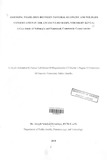Assessing Trade-offs Between Pastoral Economy And Wildlife Conservation In The Ewaso Nyiro Basin, Northern Kenya: A Case Study Of Naibung'a And Namunyak Community Conservancies

View/
Date
2010Author
Olesarioyo, Joseph S
Type
ThesisLanguage
enMetadata
Show full item recordAbstract
Naibung'a and Namunyak community conservancies as case studies have resulted from the
efforts of the Samburu and Maasai communities aimed at incorporating wildlife as a land use
into their communally owned livestock ranches in the Ewaso Nyiro Ecosystem. The idea is to
balance the use of pastureland for livestock production in co-existence with high diversity and
biomass of wildlife, thus allowing for development of eco-tourism enterprises that contributes
towards livelihoods.
This study was therefore designed to assess trade-offs between pastoral economy and
wildlife conservation in community owned conservancies in Ewaso Nyiro Ecosystem.
The study was carried out in Naibung'a Conservancy, Mukogodo Division, Laikipia District
and Namunyak wildlife conservancy in Wamba Division, Samburu East District. The specific
objectives were: (1) Determine the socio-economic and cultural factors that promote
sustainable integration of livestock keeping and wildlife conservation. (2) Characterizes
knowledge, attitudes and practices of Maasai and Samburu communities in relation to wildlife
conservation and diseases of public health significance (3) Determine benefits and constraints
of community conservation initiatives.
A variety of tools and methods used were based on the principles of participatory rural
appraisal (PRA). Semi-structured questionnaires were administered to 108 randomly selected
households during the transect walk. Maps and photos of the conservancies were taken
focusing especially the contrast between the conserved areas and the grazing land. Two
focused group discussion (n=10) were held with NRM committees. Twenty Semi-structured
interviews (SSIs) was applied obtain information on benefits and constraints of community
based conservation. Key informant interviews (n=20) were conducted with area local chiefs
and Natural Resource Managers from Naibung'a and Namunyak Conservancies.
Community participatory approaches to wildlife conservation have significant
influence on the successful natural resource management of Naibung'a and Namunyak
community conservancies (F= 10.751, d.f= 32, 77, p= < 0.000). There is also high positive
correlation between these variables and community conservation success (r2= 0.817, n= 108
households). Similarly, conservation friendly culture and ecotourism have significant
influence on change of attitudes towards game meat and general acceptance of wildlife as
alternative source of income (F= 9.831, d.f= 32, 77, p< 0.000).
The study findings shows that strong and equitable community institutions, secure
resource rights, active community participation and benefit sharing partnerships are key
governance attributes for successful and sustainable community-based conservation
Naibung'a and Namunyak. Pastoralists have ethnoveterinary knowledge that could be
integrated with the modern medicine. They have used this ethnoveterinary knowledge to
manage zoonotic diseases at the livestock-wildlife interface.
Using pairwise matrix chart and disease incidence scoring, the most prevalent
zoonotic diseases in Naibung'a are Brucellosis (28.6%) and Tuberculosis (33.3%). Other
recorded disease cases are Rabies (6.0%), Anthrax (21.0%), and Typhoid (6.1 %). The mean
average numbers of people affected by these zoonotic diseases are 22.38 and 47.26 (n=40) for
adults and children respectively. Some of the benefits of having wildlife conservation
alongside livestock production include; employment creation, conservation of threatened
medicinal plant and species, economic gain though ecotourism, enhance pasture management
through zonation, and there is increased security for wildlife and people.
The constraints faced by these community conservation initiatives include:
Weak or unclear community rights to land, water, other natural resources and the
benefits from their management.
Imperfect processes for developing policies for community-based conservation or
devolved resource control.
• Failure of policies to address the underlying causes of resource degradation, e.g. trade
terms, debt and debt servicing, lack of valuation of natural resources.
• Lack of community capacity for transforming natural capital/adding value
The study recommends that:
• There is need to build capacity among members of the conservancy on sustainable use
and management of their natural resources.
• Establish a clearly defined zoning plan, strengthen and expand the wildlife
management programmes in the conservancy.
• The need for change of centralized support with greater flexibility and opportunities
for innovation with emphasis on the resource managers
Further research is also needed to evaluate the costs and benefits of conservation to
communities, and the extent to which local conservation efforts benefit wider society (e.g.
quantity of water provided), to strengthen arguments for community payments for
environmental services.
Citation
Master Of Science In Pharmacology And Toxicology, The University of Nairobi, 2010Publisher
University of Nairobi. Department of Public Health, Pharmacology and Toxicology
